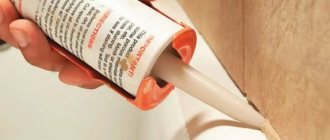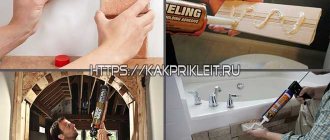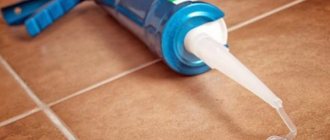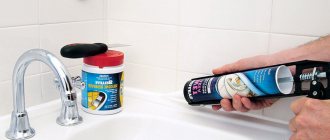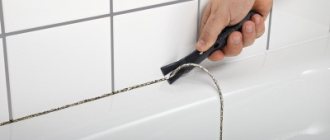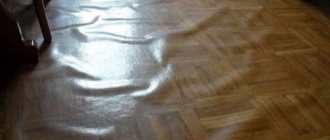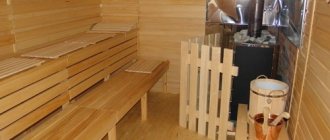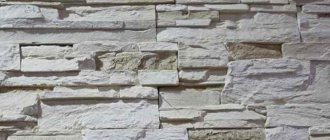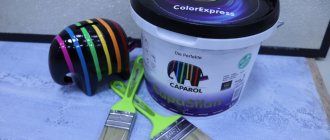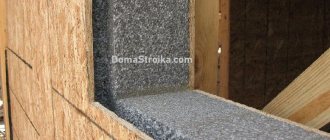Main types of sealants
Headlight sealant is available in different forms and with different base substances. The technical characteristics depend on the type of composition. To understand which sealant to use to glue headlights, you need to study each one.
Headlight sealant is available in different forms and with different base substances.
Silicone
The silicone type of composition can be used as a sealant for gluing the glass of front and rear headlights. Suitable for working with glass sunroofs and other car parts. The product has a good level of adhesion, resistance to vibration and high temperatures. However, it is not resistant to chemicals.
Used on plastic and metal surfaces.
The product has a good level of adhesion, resistance to vibration and high temperatures.
Polyurethane
The difference from the previous type is exposure to aggressive substances. Resistant to mold, mild acids and alkalis. The liquid consistency is well distributed over the base, creating a barrier against the penetration of external elements into the headlight.
Polyurethane sealant for headlights does not shrink, but does not perform well during vibrations due to poor elasticity. A long service life is ensured, which can reach 25 years.
Resistant to mold, mild acids and alkalis.
Anaerobic
The setting starts when the parts are connected, this simplifies the process of applying the composition. It is resistant to mechanical loads, vibrations, high temperatures, aggressive and chemical substances.
Resistance to mechanical loads, vibrations, and high temperatures is demonstrated.
Heat resistant
Thermal sealants for headlights are produced in two components. Before use, the substances from the tubes are mixed together. The purpose of the compositions is for connecting halogen lamps, where heating reaches +300 degrees. There are species that can withstand up to +400 degrees. Withstands chemicals. The layer dries in 8-12 hours.
Withstands chemicals.
Butyl
Butyl headlight sealant comes in thick strips. They are resistant to chemical elements, aggressive environments, and vibrations. Durability is 7-10 years.
The tape material is distributed over the surface, then the glass is pressed. A plus is the lack of need to wear PPE when working, due to its harmlessness.
They are resistant to chemical elements, aggressive environments, and vibrations.
TOP 6 Best sealants for car headlights
APRO AS-904
Butyl sealant for headlights in the form of a roller with a diameter of 6 mm (± 0.6 mm) - black. A length of 4 meters is enough to easily seal 2 headlights.
This headlight sealant is resistant to aging, never dries out, and retains its properties all the time. Adheses well to all surfaces: metal, glass, plastic, aluminum, etc.
The adhesive is resistant to water, road salt and sunlight. If necessary, the headlight adhesive can always be removed from the reflector, just heat it, for example, using a hair dryer or a heat gun.
Advantages:
- Good adhesion;
- The tape may stretch;
- No unpleasant odors;
- Hardens quickly;
- The sealant is very durable.
K2 L3050
The effective composition will ensure a second youth for all lamps made of plastic or glass. If your headlights are dim, yellowed, or have gaps in the headlight design, K2 LAMP DOCTOR Car Headlight Sealant will do a great job of filling them. Repairs can be done by hand or with a polishing machine.
Thanks to K2 LAMP DOCTOR, headlights will regain their original clarity and glow, which will directly improve their performance, road illumination and safety. K2 LAMP DOCTOR sealants can be safely used on other transparent elements such as plexiglass in motorcycles, boats and even airplanes.
The ideal complement to K2 LAMP DOCTOR is the coating, K2 Lamp Protect, which protects lamps from fading, yellowing, scratches and UV radiation for up to a year after application.
Advantages:
- Frost-resistant;
- Elastic;
- Hardens quickly;
- Durable seam.
VersaChem Mega Gray
Specialized sealant for repairing headlights, especially recommended for Japanese cars. Meets the requirements of car manufacturers (OEM - Original Equipment Manufacturer) and can be used for all car models and brands.
It is resistant to oils, greases, coolants, diesel oil, water, UV radiation, etc. Temperature range: -73°C to +343°C.
Advantages:
- Durable seams;
- Moisture resistant;
- Over time it does not lose its properties.
Quixx Headlight Upgrade Kit
Polishing paste and sealant for headlights. Matting and yellowing of car headlights dramatically reduces their brightness!
Reduced visibility while driving is a threat to all drivers. The QUIXX headlight repair kit solves this problem quickly, permanently and intelligently.
Features and Benefits:
- Removes yellowed and dull layers and fine scratches, making the reflector lens clear.
- Improves driving safety by restoring proper road lighting and improving visibility.
- Allows you to avoid costly repairs and replacement of headlights.
- The headlight adhesive sealant included in the kit leaves a durable protective layer and increases resistance to scratches and yellowing.
- The fully equipped kit contains all the components needed for the repair.
- The amazing effect is achieved thanks to plastic deformation technology (PDT).
SikaLastomer 710
SikaLastomer-710 Butyl Headlight Sealant is an excellent solvent based sealant with a paste consistency. Curing occurs by physical drying. The product is used to create reliable seals in many industries.
SikaLastomer - 710 is manufactured in accordance with the ISO 9001/14001 system, which guarantees high and consistent material quality.
Advantages:
- Fast curing;
- Easy to apply;
- Weather resistant;
- Good grip;
SILKAM
SILKAM headlight glass sealant is a specialized adhesive and sealing composition for gluing and joining elements made of glass, wood, metal and plastic.
SILKAM does not stain the surface and does not corrode metal elements, making it ideal for embedding and joining. The manufactured joints are very durable.
SILKAM sets quickly when exposed to moisture from the air, has minimal shrinkage, very good resistance to ultraviolet radiation and weather conditions, thereby creating a strong, durable, flexible and tight connection that protects against water penetration. After curing, it remains plastic in the temperature range from -30 ° C to + 120 ° C, thanks to which the connected elements can be disassembled without damaging them.
Criteria for selecting sealant for headlights
The choice of which sealant to use for headlights is made taking into account the color scheme, operating temperature, degree of adhesion, and resistance to vibration. Ease of use is also an important criterion. Often the products set quickly, so you need to have time to spread the liquid composition over the surface in a thin layer.
An important criterion is ease of use.
Bonding level
Headlight adhesive must have a high level of adhesion to the base in order to withstand the loads exerted on the part. When choosing, pay attention to the type of material where the glass will be glued and the working conditions.
Headlight adhesive must have a high level of adhesion to the base in order to withstand the loads exerted on the part.
Anti-vibration properties
The car is constantly moving, so all elements are constantly exposed to varying degrees of vibration. Sealants for headlights are resistant to such loads, but you should pay special attention to the characteristics.
Sealants for headlights are resistant to such loads.
Ease of removal
To get a beautiful result without difficulty, it is required that excess particles can be easily removed from various materials on which they may fall during work.
To get a beautiful result without difficulty, it is required that excess particles can be easily removed from different materials.
Temperature resistance
This parameter is important because high temperatures occur during repair and operation. The level of resistance depends on the substance used in the base of the product.
This parameter is important because high temperatures occur during repair and operation.
Transparency
A transparent composition is required if you are going to repair the headlight locally. If it is installed on a base, then it will be possible to use black or tape types of products.
A transparent composition is required if you are going to repair the headlight locally.
Packaging volume
Packaging volumes vary; to choose the best option, take into account the volume and its cost. Shelf life and average consumption levels are also important.
Packaging volumes vary; to choose the best option, take into account the volume and its cost.
Cost and quality
Professionals say that the optimal choice would be to choose products that fall into the middle and expensive price range. Cheap options perform poorly during operation, missing external factors, or are not transparent enough. As a result, the headlights become dim.
Professionals say that the optimal choice would be to choose products that are in the middle and expensive price range.
Types of sealants
Special sealing compounds for headlights have a very specific purpose. They are used for minor repairs and installation of automotive optics made of transparent plastic or glass in order to obtain the most airtight connection.
Waterproof sealants perform the following tasks:
- prevent the penetration of water, air and dirt into the device;
- eliminate the appearance of condensation and a decrease in the quality of lighting;
- minimize the risk of damage to the diffuser and other metal elements;
- ensure strong joining of parts without the risk of peeling off.
In car stores, sealant for gluing headlight glasses is a popular product, because optics often fail and are the first to deteriorate during accidents. Most of these products are suitable not only for materials for making headlights: sealants perfectly glue wood, leather, fabrics, ceramics, and many are used for metal.
Sealing agents can have different compositions, but most of them are sold in finished form and are single-component.
Silicone sealants
Products containing silicone are widely used in the installation of headlights, lanterns, and car windows. They are created on the basis of rubber and its subtypes (siloxanes, fluorosiloxanes and others), and represent a transparent elastic mass. Silicone sealants also contain vulcanizers, which impart strength and elasticity like rubber, ensuring no damage when in contact with water.
Typically, silicone compounds are used to seal cracks up to 6 mm deep or glue various parts together to seal joints. They help eliminate minor defects and unevenness of the base, easily withstand heating up to +250 degrees and above (products with the addition of copper - up to +375 degrees), and do not deteriorate from temperature changes. The big disadvantage of silicone is its poor tolerance to petrochemicals and a number of other substances that are used in cars . Therefore, silicone sealants can be used where there is no contact with such liquids.
Polyurethane compounds
Products with polymers based on urethane groups are considered the most popular for the repair and installation of optics. Car enthusiasts prefer them for their versatility, because sealants are excellent for gluing and protecting many body and working parts of a car. Their properties are:
- high degree of adhesion with most known materials - plastic, glass, ceramics, rubber, wood, metal;
- excellent moisture resistance, air tightness;
- work in a wide temperature range, tolerance of changes from -60 to +80 degrees or more;
- long service life (up to 25 years);
- resistance to petrochemicals, weak acids, alkalis, other aggressive substances, as well as microbes, fungi, mold;
- uniform filling of even small cracks and seams, the ability to glue optics of any geometry;
- no shrinkage after polymerization.
Polyurethane compounds, after hardening, have slightly less elasticity than silicone ones. Because of this hardness, they are not recommended for use on connections subject to strong vibration, although they are good for headlights. Also, sealants are not suitable for installing dismountable joints: they are so strong that removing them will be problematic.
Sealants contain toxic solvents, so safety precautions must be strictly observed when applying and drying. With prolonged exposure to temperatures above +100...+120 degrees, the sealant layer is destroyed, which must be taken into account during operation.
Anaerobic compounds
Such products harden only when contact with oxygen ceases, maintaining their plasticity in air. They can be slowly applied to the parts and pressed tightly together, which is convenient for the craftsman. But in a vacuum, the process of rapid polymerization begins, as a result of which a strong seam is formed in a couple of minutes. Anaerobic sealants do not deteriorate at temperatures ranging from -80...+175 degrees, and are resistant to:
- fuel;
- oils;
- antifreeze;
- alkalis;
- weak acids.
The products create a reliable cushioning layer and help mount optics, front and rear windows, as well as seal body joints, threaded connections, and flanges. After hardening, a hard, durable plastic is formed at the site where the composition is applied, which lasts a long time, does not deform, does not shrink or expand. The ease of use is beyond doubt - there is no need for quick application, no physical effort for gluing, safety for humans and the environment.
Heat-resistant sealants
These compounds are characterized by increased strength and lack of reaction to high temperatures (usually up to +375 degrees). They are rarely used for repairing and installing headlights, because such connections are not subject to thermal stress. The finished seam is not afraid of shocks, shocks, vibrations, water and aggressive substances. The disadvantages of heat-resistant sealants are increased cost and long polymerization (8-12 hours until completely dry).
Popular headlight sealants
They decide on which sealant to install the headlight glass, taking into account the popularity of the compositions, among other things. There are a huge number of sealants for this purpose on the construction market, but it will be easier for a beginner to choose among the variety of options based on consumer reviews. There are five popular and high-quality products:
- ABRO WS 904;
- Dow Corning 7091;
- DoneDeal DD6870;
- 3M PU 590;
- Emfimastic PB.
It will be easier for a beginner to choose among a variety of options based on consumer reviews.
Rules for applying and removing old sealant
Depending on which sealant you need to glue the headlight glass, you need to apply the substance correctly, following the manufacturer’s recommendations. In order not to disrupt the light transmission and optical properties of the headlights, you need to follow simple rules:
- When applying liquid products, use a dispenser and press down the parts well.
- Before using tape sealants, the surface must be cleaned and degreased.
- Before using the compositions in a cold room, the product is heated with a hairdryer.
The type of sealant used to glue the headlights depends on the type of glass. If there is a layer of old glue left on the surface, it must be removed. Excess mass after gluing must also be removed. To soften the dried old layer, use a hairdryer. You need to work carefully, trying not to damage the special protective film on the optics. It is very difficult for polyurethane materials to “lag behind” headlights. In this case, you need to use a headlight dismantling liquid on a polyurethane sealant. The optics mounted on the thermal compound are re-glued with the same glue.
Instructions for use
In order for the repair to be of high quality, it is necessary to adhere to the rules of work. The gluing technology consists of the following steps:
- Remains of the old coating are removed;
- The surface is degreased and applied if a primer solution is included in the package;
- The liquid product is applied through a special tip or gun. The tape version requires heating and stretching along the base;
- The headlight is attached to the desired area;
- The element is compressed until the solidification process is completed.
In order for the repair to be of high quality, it is necessary to adhere to the rules of work.
How to remove sealant from a headlight or glass
One of the most effective methods is to heat the sealant. After softening, it is freely removed. When doing this, be careful not to melt the plastic elements of the headlight unit. Residues can be removed with any automotive solvent and a flat screwdriver: the main thing is not to scratch the surface and wait 10-15 minutes. Then you can carefully scrape off the excess with a knife.
The choice of one or another sealing composition depends on the type of lamp in the headlight. In normal cases, polyurethane or silicone products are suitable, but if the optics are halogen-filled, use heat-resistant sealants, which can be found at any auto store.
If you have any questions, leave them in the comments below the article. We or our visitors will be happy to answer them
How to Remove Car Headlight Sealant
There are many options for how to remove excess sealant from the surface. The choice is made taking into account the working conditions. The techniques that can be used will be described below.
The choice is made taking into account the working conditions.
Using a hair dryer
Using a hair dryer, the layer heats up and eventually loses its durability. But the use of high temperatures is not allowed when working with a plastic base.
Using a hair dryer, the layer heats up and eventually loses its durability.
Using a knife or screwdriver
Working with sharp tools is simple, but if a layer is removed from parts that are visible and should be without flaws, then it is better not to resort to the method. Otherwise, you may leave scratches on the surface.
Working with sharp tools is simple, but if a layer is removed from parts that are visible and should be without flaws, then it is better not to resort to the method.
Use of solvent
Thinners can be used after heating and scraping work. Or applied in a separate way. Acetone or automotive thinner is suitable for removal. The layer is soaked in the product for 5-15 minutes, after which the sealant is removed.
Thinners can be used after heating and scraping work.
Using a body degreaser
This product does a good job of softening the sealant layer; when the composition has worked, the residue is removed using a rag and non-sharp tools.
This product does a good job of softening the sealant layer.
White spirit, solvent, nefras
These types of thinners can cope with removing the old layer of sealants. Also used as degreasers before new work.
They can cope with removing the old layer of sealing agents.
Using alcohol
The alcohol base is only suitable for working with pre-scraped layers when the joint has already lost its strength. Or alcohol is used to clean the headlights.
The alcohol base is only suitable for working with pre-scraped layers when the joint has already lost its strength.
The best way to glue headlight glass: types of sealants
The market offers a fairly extensive range of compositions that differ in chemical properties, ease of use, and cost. What to choose? First you need to understand the classification. There are 4 types of sealants for headlights and car glass.
For better bonding, it is better to dismantle the headlight
Silicone
In terms of composition before polymerization, these are semi-liquid fluid products made from natural or artificial rubber. After application, the material hardens, turning into a kind of rubber that glues surfaces, protects from UV radiation and seals joints. But silicone products have a significant disadvantage - poor resistance to chemically aggressive environments, for example, technical oil, gasoline, diesel fuel, etc. This is especially important if the car has a headlight washer system, which uses a special liquid that contributes to the process of destroying the sealant, but sometimes oil-resistant products are found. In winter, it is also affected by anti-ice reagents. The main advantage of silicone compounds is their low cost and the ability not to lose their properties over a wide temperature range - up to +100°C. Ideal for mounting fog lamp lenses.
Polyurethane
These automotive sealants are very helpful in situations where you need to glue individual fragments of broken headlight glass or simply repair a chip or crack. The main advantage of polyurethane compounds is high adhesion (stickability) and good adhesive properties. Dried polyurethane based sealant is water resistant.
There are other advantages:
- The adhesive material can be used in a wide temperature range - from minus 60 to plus 80°C;
- service life reaches several years;
- the composition is resistant to the effects of motor oil, fuel, alcohol washer fluid and anti-ice agents;
- good fluidity before polymerization makes it possible to connect fragments of the most complex configuration;
- frost resistance;
- The glued structure reliably resists vibration.
Polyurethane sealant: everything is written on the package
But what about the disadvantages? They are also available. The first is toxicity, which requires compliance with special safety rules: you need to work in rubber gloves, goggles, and sometimes a respirator (if the amount of work is large, for example, in a machine shop). And another disadvantage is poor resistance to high (more than +120°C) temperatures, which is typical for halogen lamps. However, the product is quite suitable for repairing mirrors.
Anaerobic
These compositions are characterized by high strength and resistance to high temperatures (up to +200°C). Sealants of this type are used for sealing joints and seams. Before polymerization, anaerobic sealants are in liquid form. Because of this, there are some inconveniences during use. But the chemical composition of the product is harmless to humans, and additional protection in the form of gloves and glasses is not required. The only requirement is to prevent the sealant from getting into your mouth and eyes.
Heat resistant (high temperature)
The main advantage of these sealants for headlights and car glass follows from their name. Compositions of this type can easily withstand temperatures up to +300 and even +400°C. That is, these heat sealants are well suited for working with headlight lenses that contain halogen lamps. The heat-resistant product is quite durable and is not afraid of vibration and mechanical impact. Heat-resistant sealants are produced in paste form or in two-component form. There is also a drawback to high-temperature auto sealant - a long hardening time, reaching up to 8-12 hours.
Mistakes when choosing and using sealants
To get a long-lasting result, a beginner needs to take into account common mistakes in choosing a sealant and its use. The following points are highlighted:
- Incorrect selection of product in terms of transparency and resistance to high temperatures;
- Working with an unprepared base;
- Weak compression force when anaerobic adhesives are used;
- Applying the product in a layer that is too thick;
- The sealant is applied to the old layer.
Incorrect selection of product in terms of transparency and resistance to high temperatures.
Useful tips
When working in a garage where the heating is poor, it is better to warm up the sealant and base. Working with halogen headlights is difficult, so in this case it is better to resort to the services of specialists. The remaining adhesive is removed from the outer surface after the layer has hardened.
When working in a garage where the heating is poor, it is better to warm up the sealant and base.
Headlight glass sealant will help make repairs that are durable and unnoticeable. But when working, you should follow the technology; it is also important to choose the appropriate option, taking into account all the features of the material and operating conditions.
Polyurethane compounds
If you are looking for a clear sealant for headlights, we recommend purchasing a polyurethane-based product. It will make it easy to carry out minor repairs to optics with your own hands, gluing even the smallest cracks.
The positive properties are that they:
- Withstands temperatures from -60 to +80.
- They are persistent and durable (can last at least a couple of years).
- Resistant to various types of fuel and even alcohol.
- They are characterized by high fluidity, which allows them to be used to mask small cracks.
- Withstand vibrations.
The disadvantages include:
- harmful fumes for the body (therefore not suitable for household use);
- the fact that they often cannot withstand temperatures up to +120 degrees, therefore they are not suitable for halogen headlights.
Otherwise, if you are looking for a sealant to use for gluing headlight glass, a polyurethane-based product is best suited.

